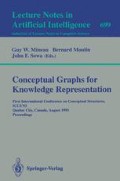Abstract
Although logic is general enough to describe anything that can be implemented on a digital computer, the unreadability of predicate calculus makes it unpopular as a design language. Instead, many graphic notations have been developed, each for a narrow range of purposes. Conceptual graphs are a graphic system of logic that is as general as predicate calculus, but they are as readable as the special-purpose diagrams. In fact, many popular diagrams can be viewed as special cases of conceptual graphs: type hierarchies, entity-relationship diagrams, parse trees, dataflow diagrams, flow charts, state-transition diagrams, and Petri nets. This paper shows how such diagrams can be translated to conceptual graphs and thence into other systems of logic, such as the Knowledge Interchange Format (KIF).
Preview
Unable to display preview. Download preview PDF.
References
Chen, Peter Pin-Shan (1976) “The entity-relationship model-toward a unified view of data,” ACM Transactions on Database Systems 1:1, pp. 9–36.
Chomsky, Noam (1957) Syntactic Structures, Mouton, The Hague.
Genesereth, M. R., & R. E. Fikes (1992) “Knowledge Interchange Format, Version 3.0 Reference Manual,” Report Logic-92-1, Computer Science Department, Stanford University.
Gentzen, Gerhard (1934) “Untersuchungen über das logische Schliessen”, Mathematische Zeitschrift, XXXIX, 176–210.
Kifer, Michael, & Georg Lausen (1989) “F-logic: A higher-order language for reasoning about objects, inheritance, and scheme,” Proc. 1989 ACM SIGMOD Conference, pp. 134–146.
Levinson, Robert A., & Gerard Ellis (1992) “Multilevel hierarchical retrieval,” Knowledge Based Systems, vol. 5, no. 3, pp. 233–244.
Nagle, T. E., J. A. Nagle, L. L. Gerholz, & P. W. Eklund, eds. (1992) Conceptual Structures: Current Research and Practice, Ellis Horwood, New York.
Peirce, Charles Sanders (1898) Reasoning and the Logic of Things: The Cambridge Conferences Lectures of 1898, ed. by K. L. Ketner, Harvard University Press, Cambridge, MA, 1992.
Perez, Sandra, & Anthony Sarris, eds. (1993) IRDS Conceptual Schema, X3H4 Technical Report, American National Standards Institute, New York.
Roberts, Don D. (1973) The Existential Graphs of Charles S. Peirce, Mouton, The Hague.
Sowa, John F. (1984) Conceptual Structures: Information Processing in Mind and Machine, Addison-Wesley, Reading, MA.
Sowa, John F. (1993) “Logical foundations for representing object-oriented systems,” Journal of Experimental and Theoretical Artificial Intelligence (JETAI) to appear in vol. 5.
Tesnière, Lucien (1959) Eléments de Syntaxe Structurale, 2nd edition, Librairie C. Klincksieck, Paris, 1965.
Whitehead, Alfred North, & Bertrand Russell (1910) Principia Mathematica, Cambridge University Press, Cambridge.
Author information
Authors and Affiliations
Editor information
Rights and permissions
Copyright information
© 1993 Springer-Verlag Berlin Heidelberg
About this paper
Cite this paper
Sowa, J.F. (1993). Relating diagrams to logic. In: Mineau, G.W., Moulin, B., Sowa, J.F. (eds) Conceptual Graphs for Knowledge Representation. ICCS 1993. Lecture Notes in Computer Science, vol 699. Springer, Berlin, Heidelberg. https://doi.org/10.1007/3-540-56979-0_1
Download citation
DOI: https://doi.org/10.1007/3-540-56979-0_1
Published:
Publisher Name: Springer, Berlin, Heidelberg
Print ISBN: 978-3-540-56979-4
Online ISBN: 978-3-540-47848-5
eBook Packages: Springer Book Archive

